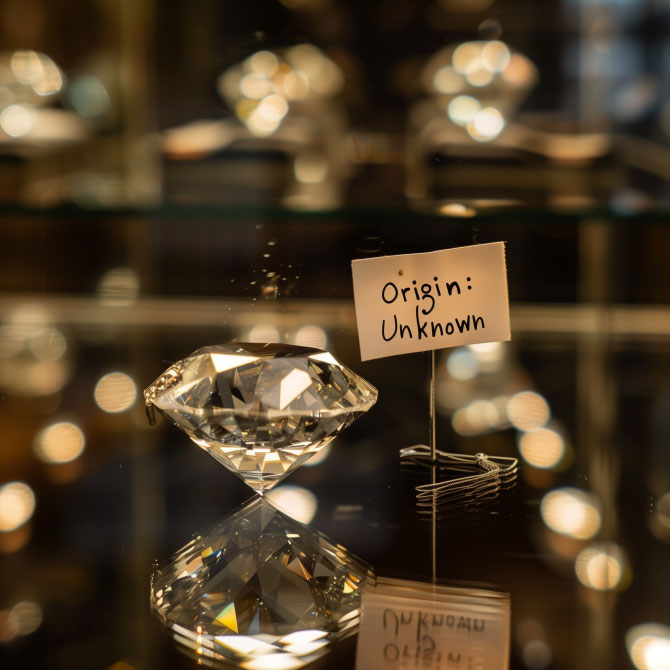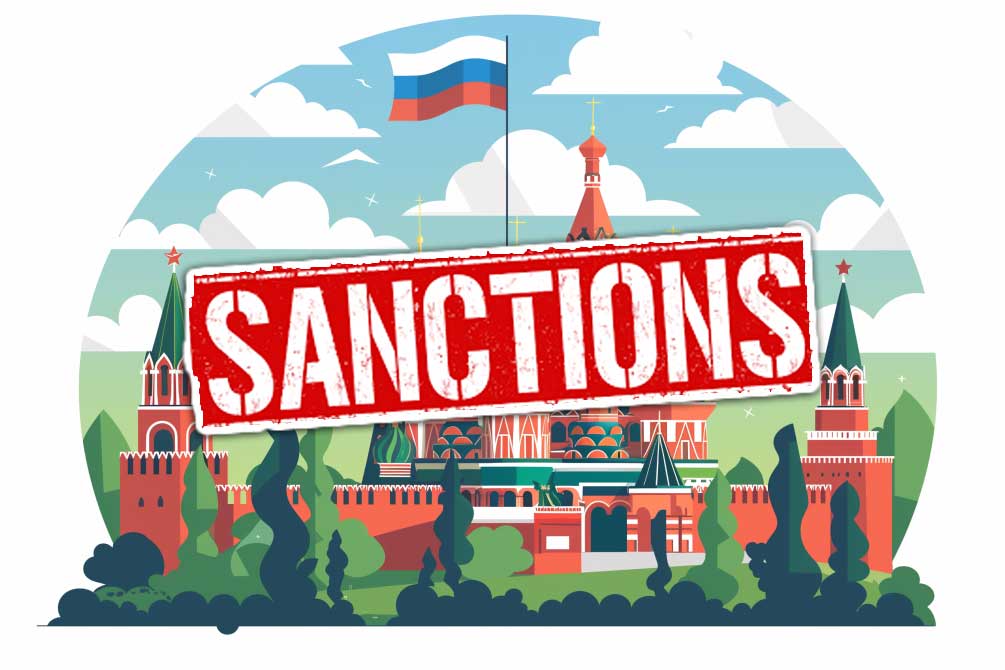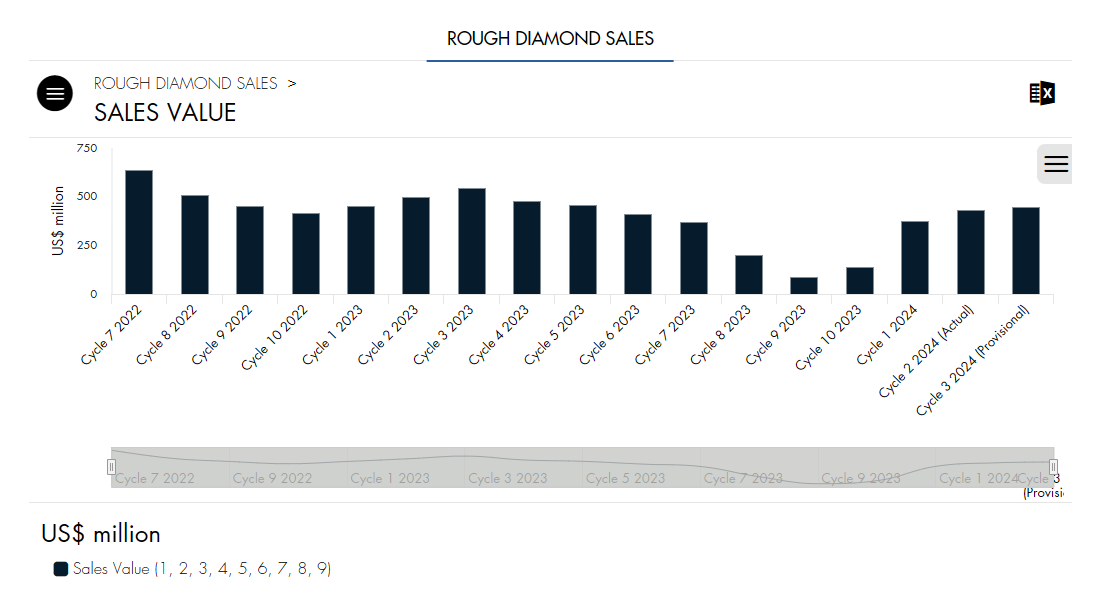Diamond Industry News: The Truth About Origin And Traceability
… and the recent G7 “Russian Diamond” sanctions.
"Where does the diamond on my finger come from?" - an end-consumer may ask. What on the outset looks like a harmless question may lead to a complicated and possibly troubling answer:

The diamond industry is one of the most regulated industries in the world. [1] And for a good reason, the industry has been no stranger to legal and ethical issues related to its sourcing of goods:
- Governments have attempted to tackle these issues through global agreements, such as the Kimberley Process (KPCS). [2]
- Later, the WDC implemented the System of Warranties (SoW), conceived as a self-regulatory framework mandating B2B players to include a warranty statement on invoices and memos each time a diamond is exchanged. [3]
- Recent G7 Regulations attempt to put further sanctions on Russia, one of the biggest diamond exporters.
But… can you really know where the polished diamond an end-consumer buys in a store comes from? How interwoven is the diamond industry's supply chain? Is it possible to stop a country from selling its diamonds internationally?
In this article we'll uncover the uncomfortable truth about sourcing and traceability, and how it relates to recent events in the diamond industry:
It's no secret that the diamond industry has a complex and multi-faceted supply chain. The diamond may pass through many different hands, companies, and locations before it finally becomes polished jewelry in a store.
Tracking becomes increasingly difficult as supply chains grow more complex. This difficulty is compounded in the diamond industry, as polished diamonds reveal little about their origins.
Dr. James E. Shigley of the Gemological Institute of America stated in a recent interview [4]:
“It’s much more similar to a chain of custody [...] This is what I think is possible today. This is what we do, and I don’t think there’s any way of telling this [just] from studying a polished diamond.”
Due to the inability to trace the origin of polished stones in the diamond industry, we face these two hard challenges.

The Two Hardest Challenges Of Traceability
- How to trace the rough diamonds when the entity changes (sorting, splitting, mixing, etc) and retain that custody for one provider (mine or factory)?
- How can all goods be tracked as they move downstream, passing party to party throughout the pipeline?
While the first challenge is already solved with proprietary technology, such as BidGemmer’s “diamond ERP and stock inventory management.” - and some other blockchain solutions…
… the second challenge is still largely unsolved.
Many companies have tried to come up with their own solution to tackle the tracking solution:
- Tracr
- Everledger
- Sarine
- iTraceIt
- Authentia
One of the most notable solutions is Tracr from De Beers, as the company has sufficient scale to create a proprietary solution that tracks stones in its ecosystem accurately. Moreover, De Beers also opened up the platform to the industry for further adoption.
However, De Beers has recently reported tracking 200,000 stones - which pales to the total amount of new and polished, natural loose stones in circulation. [5]
So while TRACR and the other of the aforementioned solutions are a great step in the right direction, true end-to-end tracking would only be possible through seamless integrations of all solutions.
Integrations that - without third-party regulations - may never happen.

What about the Blockchain?
Many people use the term Blockchain in the industry as the “solution” for origin and traceability issues.
For good reason: Blockchain technology may offer transparent, permanent, and incorruptible data points (blocks) that are stored in chronological order (chain).
The problem? While Blockchain might be a promising technology, it’s unfortunately not a solution in and of itself.
There are three main reasons for this:
- Interchangeability: Even if every transaction is recorded, there's no way to ensure the stone wasn't secretly swapped. Malicious actors can log a stone on the blockchain and then replace it with a different stone in the next step.
- Reporting need: Who checks that the ‘chain’ is complete - or ended abruptly? Ultimately, it's up to the individual or the company to report honestly, which can not always be counted upon.
- Unified-tracking needs: Even if one party of the supply chain tracks diligently, there's no guarantee that all the other parties downstream will do the same (or even use the same platform to track the stone).
Unfortunately - at the current stage - Blockchain is more often used as a ‘buzzword’ rather than a complete solution to the tracking problem.
But… how can the tracking problem possibly be solved?
The Wider Industry Solution To The Traceability Problem
We believe there’s only one permanent solution to the traceability problem: The entire industry would require a unified tracking system at every step—from the mine to the jeweler.
A unified tracking system, that ultimately encompasses every touchpoint of the supply chain.
Said tracking system would require unprecedented collaboration between the diamond companies. The chances of which is dwindling every day as companies are developing their own custom solution (that do not necessarily integrate with other competing solutions).
Until recent events that have prompted a shift in industry perspective.

G7 Sanctions: The Recent Catalyst
With the ongoing conflict in East Europe, the G7 countries - which are made up of the United States, Canada, France, Germany, Italy, Japan, the United Kingdom, and the European Union - imposed Russia with further sanctions on its diamond export. [6]
The sanctions turn out to be rather troubling to implement due to the aforementioned traceability issues and Russia being the 9th largest diamond exporter. [7]
The CNN summed up the situation nicely [8]:
“In other words, even if stones are sent halfway around the world for cutting and polishing, if they originated in Russia they’ll be banned from markets in Europe and the G7. And the industry will need to figure out how to prove it.”
Understandably, the diamond industry believes that this additional burden of proof is not fair at best - and impossible to implement at worst.
The following are the biggest reasons for opposition to the G7 sanctions:

The 3 Main Reasons For Opposition To The G7 Sanctions
Almost instantly, 146 companies signed a letter of complaint to the Antwerp World Diamond Centre about the restrictions. [9]
Industry and country-wide, the reactions to the G7 sanctions are of a mixed nature. And there are valid reasons why:
1. Leading Countries Continue to Battle G7 Sanctions
While Hong Kong, China, United States do not currently require a G7 certificate - the biggest opposition to the G7 Sanctions is India. For good reasons:
India is both the world’s largest importer and exporter of diamonds. [10] The country cuts and polishes about 90% of the world’s diamonds, which they often sell to the US market. [11]
Since the sanctions on Russia, India’s imports of diamonds from Russia have surged. [12]
As such, India’s foreign affairs minister Subrahmanyam Jaishankar believes the G7's sanctions on Russian diamonds will have a proportionally large effect on the economy. According to DiamondWorld:
“[...] hundreds of thousands of jobs in the country rely on Russian goods.”
India’s foreign affairs minister is determined to delay, soften, or prevent the ban altogether. [13]
2. Overall Confusion
Many diamond industry insiders report that the dust hasn’t yet been properly settled. Many unanswered questions exist regarding the practical traceability requirements imposed by the G7 sanctions, such as:
- What about grandfathered goods? Imagine you’ve stored a 20-year-old diamond from Russia. Or even from last year (or before the conflict). Are they treated with the same restrictions?
- Imagine you’ve already imported a diamond from Russia before the sanctions. Can they be exported and reimported?
- What about a multi-origin lot? If you have a multi-origin parcel, are they undergoing the same restrictions?
- What about smaller stones? Properly tracking their origin may severely impact the stone’s profitability or not be possible at all. Factories are not typically structured to segregate based on origin, as this approach is not operationally viable.
The G7 Sanctions are leaving many diamond companies in disarray. BDB president Anoop Mehta summed it up nicely: [14]
“So, the whole industry is all up in a mess.”
The biggest cause for confusion and worry is certainly the cost implications of the additional traceability needs in an already troubled industry:
3. Raising Costs Throughout The Supply Chain
Sending goods to a testing center in Belgium or installing state-of-the-art traceability technology is expensive.
Those requirements will inevitably reduce the profitability of naturally sourced diamonds further in an industry that is troubled by strongly reduced demand in the previous year: [15]

Understandably, the G7 Sanctions are therefore met with mixed reactions.
Conclusion: The Truth About Origin And Traceability
The uncomfortable truth about the diamond that the end-consumer buys is that - at the current state - no one really knows for sure where it comes from.
Naturally sourced diamonds have a complex and multi-faceted supply chain, and according to prominent scientists, the polished stone doesn’t have any clues to its geographical origin.
To comply with recent G7 sanctions, the industry will likely need to adopt a unified tracking solution at every touchpoint of the supply chain, from the miner to the jeweler.
This would either require an integration between multiple (if not all) tracking providers - or a new tracking provider that would be provided (or subsidized) by regulators.
While adhering to new regulations may deliver short-term implications on the profitability of diamonds, we believe that long-term the demand for naturally sourced diamonds is robust and will fully recover.
Companies in the industry are well-advised to embrace traceability, as it's certainly here to stay.
We recommend seeing recent events as a positive catalyst for improving our industry's technology foundation and safeguarding it for the future.
About BidGemmer:
BidGemmer is an industry-leading software with a comprehensive ecosystem for the diamond industry. From sales to comprehensive tracking solutions, the software covers it all.
Our technology has been used to sell over $160B+ in auctions and has been in the market for 10+ years. You can learn more about our software here, or request a demo here: https://bidgemmer.com/get-started
References:
[1] ‘The Diamond World In Stress’ by Rami Baron - LinkedIn: https://www.linkedin.com/pulse/diamond-world-stress-rami-baron-2p1wc/?trackingId=yu1ErWU1TWCoBp%2FhSUMF5A%3D%3D .
[2] Kimberley Process: https://www.kimberleyprocess.com/en/what-kp
[3] System of Warranties by the World Diamond Council: https://www.worlddiamondcouncil.org/about-sow/
[4] Science Can’t Determine Diamond Origin, Says Top GIA Fellow: https://rapaport.com/videos/science-cant-determine-diamond-origin-says-top-gia-fellow/
[5] DeBeers LinkedIn post: https://www.linkedin.com/posts/tracrdiamonds_diamond-naturaldiamonds-poweredbytracr-activity-7119680838685839360-t8oS?utm_source=share&utm_medium=member_desktop
[6] Four Questions the US Must Answer on Diamond Sanctions: https://rapaport.com/analysis/four-questions-the-us-must-answer-on-diamond-sanctions/
[7] OEC - Diamonds in Russia: https://oec.world/en/profile/bilateral-product/diamonds/reporter/rus
[8] New sanctions on Russian diamonds will change the global trade in gems: https://edition.cnn.com/2024/01/22/style/eu-sanctions-russia-diamonds-jewelry-bof/index.html
[9] Sanctions Causing Shipment Delays in Antwerp, Traders Say: https://rapaport.com/news/sanctions-causing-shipment-delays-in-antwerp-traders-say
[10] OEC - Diamonds in India: https://oec.world/en/profile/bilateral-product/diamonds/reporter/ind
[11] India Sets Diamond Import Record in Month with $215Mln Purchase from Russia: https://sputniknews.in/20231023/india-sets-diamond-import-record-in-month-with-215mln-purchase-from-russia-5017952.html
[12] India Sets Diamond Import Record in Month with $215Mln Purchase from Russia: https://sputniknews.in/20231023/india-sets-diamond-import-record-in-month-with-215mln-purchase-from-russia-5017952.html
[13] India Continues to Battle G7 Sanctions: https://www.diamondworld.net/news/india-continues-to-battle-g7-sanctions
[14] Diamond Buyers Asking for Too Much Origin Info, Indians Say: https://rapaport.com/news/diamond-buyers-asking-for-too-much-origin-info-indians-say
[15] Rough Diamond Sales - by De Beers: https://www.debeersgroup.com/reports/rough-diamond-sales
